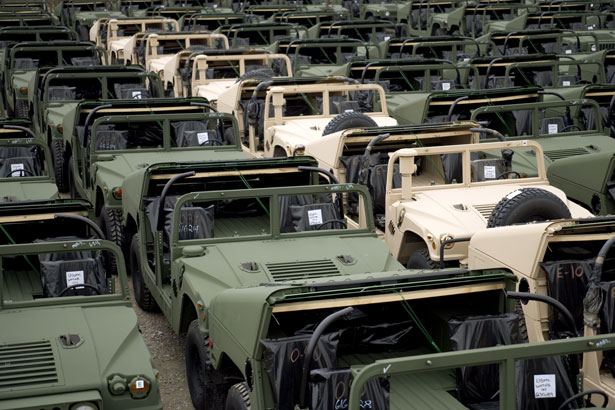
Humvees await uparmoring at the Armor Holdings plant in Fairfield, Ohio, Jan. 31, 2006. (AP Photo/Dayton Daily News, Ty Greenlees)
The following passages are excerpted from Eduardo Galeano’s new book, Children of the Days: A Calendar of Human History (Nation Books). These selections originally appeared at TomDispatch.com. To stay on top of important articles like these, sign up to receive the latest updates from TomDispatch.com.
The Day Mexico Invaded the United States
(March 9)
On this early morning in 1916, Pancho Villa crossed the border with his horsemen, set fire to the city of Columbus, killed several soldiers, nabbed a few horses and guns, and the following day was back in Mexico to tell the tale.
This lightning incursion is the only invasion the United States has suffered since its wars to break free from England.
In contrast, the United States has invaded practically every country in the entire world.
Since 1947 its Department of War has been called the Department of Defense, and its war budget the defense budget.
The names are an enigma as indecipherable as the Holy Trinity.
God’s Bomb
(August 6)
In 1945, while this day was dawning, Hiroshima lost its life. The atomic bomb’s first appearance incinerated this city and its people in an instant.
The few survivors, mutilated sleepwalkers, wandered among the smoking ruins. The burns on their naked bodies carried the stamp of the clothing they were wearing when the explosion hit. On what remained of the walls, the atom bomb’s flash left silhouettes of what had been: a woman with her arms raised, a man, a tethered horse.
Three days later, President Harry Truman spoke about the bomb over the radio.
He said: “We thank God that it has come to us, instead of to our enemies; and we pray that He may guide us to use it in His ways and for His purposes.”
Manufacturing Mistakes
(April 20)
It was among the largest military expeditions ever launched in the history of the Caribbean. And it was the greatest blunder.
The dispossessed and evicted owners of Cuba declared from Miami that they were ready to die fighting for devolution, against revolution.
The US government believed them, and their intelligence services once again proved themselves unworthy of the name.
On April 20, 1961, three days after disembarking at the Bay of Pigs, armed to the teeth and backed by warships and planes, these courageous heroes surrendered.
The World Upside Down
(March 20)
On March 20 in the year 2003, Iraq’s air force bombed the United States.
On the heels of the bombs, Iraqi troops invaded US soil.
There was collateral damage. Many civilians, most of them women and children, were killed or maimed. No one knows how many, because tradition dictates tabulating the losses suffered by invading troops and prohibits counting victims among the invaded population.
The war was inevitable. The security of Iraq and of all humanity was threatened by the weapons of mass destruction stockpiled in United States arsenals.
Popular
"swipe left below to view more authors"Swipe →
There was no basis, however, to the insidious rumors suggesting that Iraq intended to keep all the oil in Alaska.
Collateral Damage
(June 13)
Around this time in 2010 it came out that more and more US soldiers were committing suicide. It was nearly as common as death in combat.
The Pentagon promised to hire more mental health specialists, already the fastest-growing job classification in the armed forces.
The world is becoming an immense military base, and that base is becoming a mental hospital the size of the world. Inside the nuthouse, which ones are crazy? The soldiers killing themselves or the wars that oblige them to kill?
Operation Geronimo
(May 2)
Geronimo led the Apache resistance in the nineteenth century.
This chief of the invaded earned himself a nasty reputation for driving the invaders crazy with his bravery and brilliance, and in the century that followed he became the baddest bad guy in the West on screen.
Keeping to that tradition, “Operation Geronimo” was the name chosen by the US government for the execution of Osama bin Laden, who was shot and disappeared on this day in 2011.
But what did Geronimo have to do with bin Laden, the delirious caliph cooked up in the image laboratories of the US military? Was Geronimo even remotely like this professional fearmonger who would announce his intention to eat every child raw whenever a US president needed to justify a new war?
The name was not an innocent choice: the US military always considered the Indian warriors who defended their lands and dignity against foreign conquest to be terrorists.
Robots with Wings
(October 13)
Good news. On this day in the year 2011 the world’s military brass announced that drones could continue killing people.
These pilotless planes, crewed by no one, flown by remote control, are in good health: the virus that attacked them was only a passing bother.
As of now, drones have dropped their rain of bombs on defenseless victims in Afghanistan, Iraq, Pakistan, Libya, Yemen and Palestine, and their services are expected in other countries.
In the Age of the Almighty Computer, drones are the perfect warriors. They kill without remorse, obey without kidding around, and they never reveal the names of their masters.
War Against Drugs
(October 27)
In 1986, President Ronald Reagan took up the spear that Richard Nixon had raised a few years previous, and the war against drugs received a multimillion-dollar boost.
From that point on, profits escalated for drug traffickers and the big money-laundering banks; more powerful drugs came to kill twice as many people as before; every week a new jail opens in the United States, since the country with the most drug addicts always has room for a few addicts more; Afghanistan, a country invaded and occupied by the United States, became the principal supplier of nearly all the world’s heroin; and the war against drugs, which turned Colombia into one big US military base, is turning Mexico into a demented slaughterhouse.
For more on the history of US military presence abroad, read another excerpt from Eduardo Galeano’s new book here.


